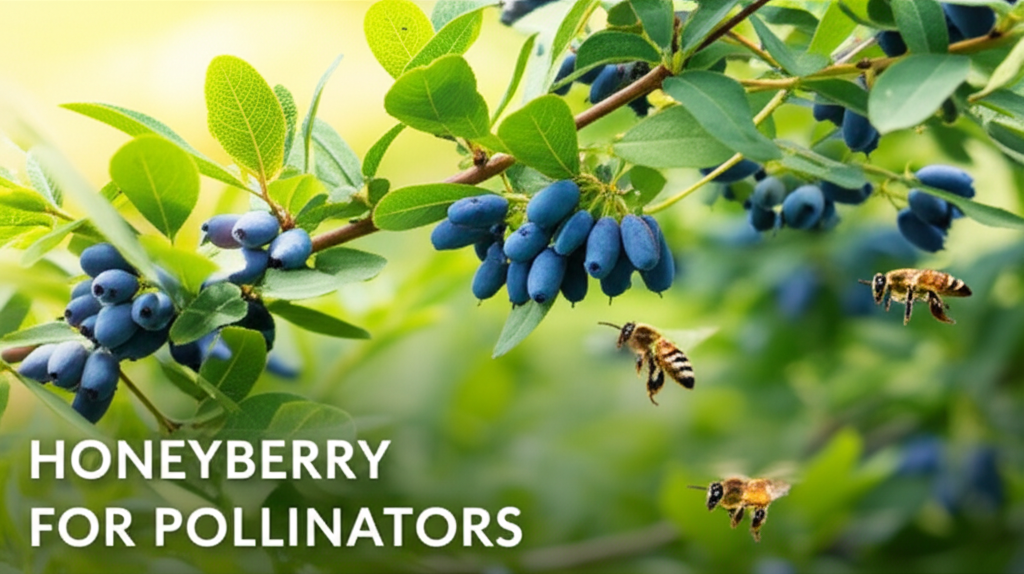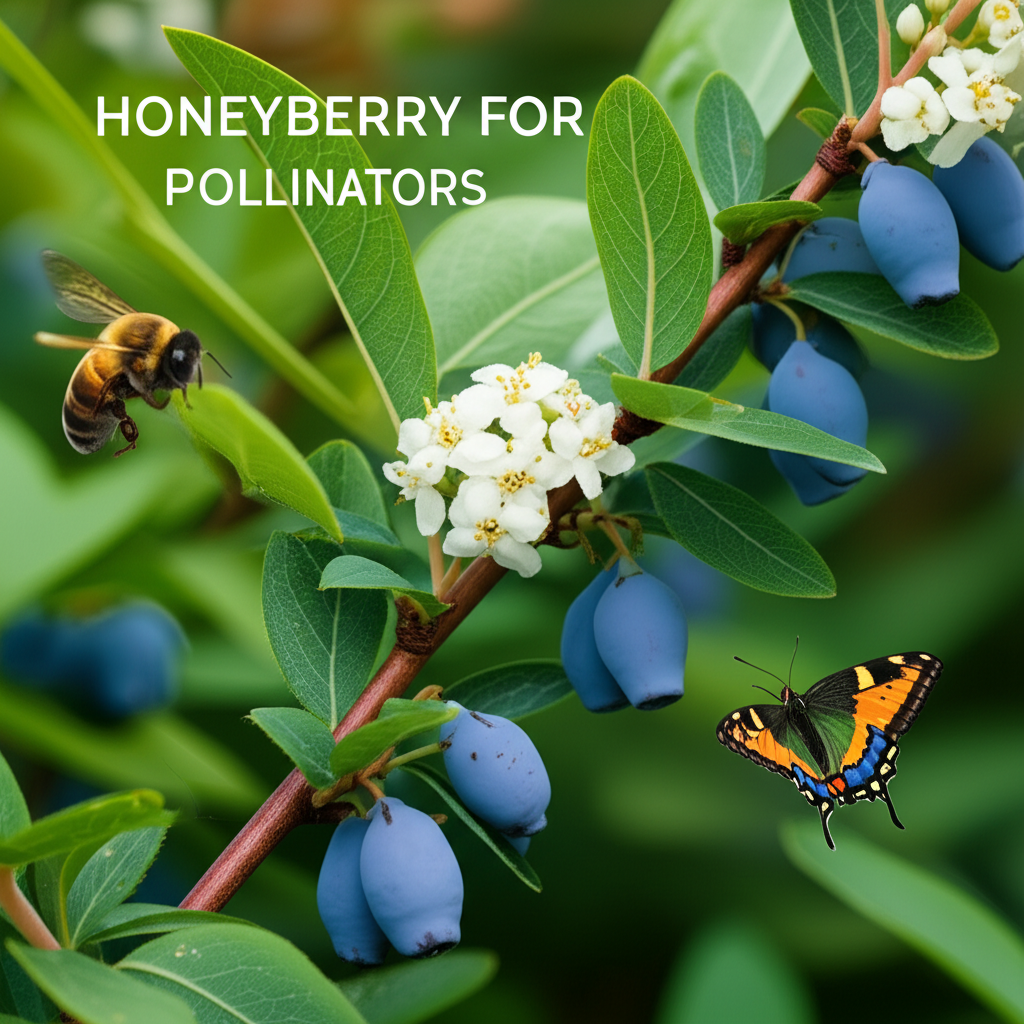The Honeyberry Shrub: A Sweet Solution for Pollinator Gardens
In the ever-growing quest for sustainable and wildlife-friendly gardening, the honeyberry shrub (also known as Haskap or Lonicera caerulea) emerges as a remarkable and often overlooked champion. This hardy, adaptable plant offers a trifecta of benefits: delicious edible berries, exceptional hardiness, and, crucially for our buzzing friends, a vital early-season nectar and pollen source. For gardeners looking to create a truly pollinator-friendly haven, incorporating honeyberries is not just an option; it’s a strategic and rewarding choice.
This comprehensive guide will delve into the fascinating world of the honeyberry shrub, exploring its unique characteristics, its vital role in supporting pollinators, and practical advice for successfully integrating it into your backyard landscape. From understanding its botanical nuances to maximizing its pollinator appeal, we’ll uncover why this unassuming shrub deserves a prime spot in any garden aiming for ecological vibrancy.
What is a Honeyberry Shrub?

The honeyberry shrub is a deciduous woody perennial belonging to the honeysuckle family (Caprifoliaceae). Native to the boreal regions of North America, Europe, and Asia, it has evolved to thrive in harsh climates, demonstrating impressive cold tolerance. Unlike its fragrant ornamental cousins, the true honeyberry is cultivated for its nutritious and flavorful berries.
Botanical Breakdown: Understanding Lonicera caerulea
The scientific name, Lonicera caerulea, hints at its lineage. Lonicera honors the German botanist Adam Lonicer, while caerulea refers to the characteristic blue hue of its ripe fruit. Varieties and cultivars have been meticulously developed, particularly in Canada and Russia, to enhance berry size, flavor, and yield, while also improving disease resistance and self-pollinating capabilities (though cross-pollination is still highly recommended for optimal fruit production).
Key Facts About the Honeyberry Shrub
Let’s distill some essential information about this valuable plant:
| Feature | Description |
|---|---|
| Scientific Name | Lonicera caerulea |
| Common Names | Honeyberry, Haskap, Blue Honeysuckle, Edible Honeysuckle |
| Family | Caprifoliaceae (Honeysuckle family) |
| Origin | Boreal regions of North America, Europe, and Asia |
| Plant Type | Deciduous woody shrub |
| Hardiness Zones | Generally Zones 2-7 (varies by cultivar) |
| Sunlight Needs | Full sun to partial shade (full sun for best fruiting) |
| Soil Preference | Well-drained, slightly acidic to neutral pH (pH 5.5-7.5) |
| Mature Size | 3-6 feet tall and wide (varies by cultivar) |
| Bloom Time | Early spring (often one of the first to bloom) |
| Fruit Type | Oblong, blue, berry-like drupes |
| Fruiting Time | Late spring to early summer (typically May-June) |
| Pollination Requirement | Cross-pollination recommended for best yield; some cultivars are partially self-fertile. |
The Honeyberry’s Irresistible Appeal to Pollinators
The early blooming nature of the honeyberry shrub is precisely what makes it so invaluable for supporting the nascent pollinator population in spring. As winter’s grip loosens and the first tentative warmth arrives, many plants are still dormant. Honeyberries, however, are often among the earliest to produce nectar and pollen, providing a critical food source for emerging bees, particularly bumblebees and solitary bees.
Why Early-Season Blooms Matter
Pollinators emerge from hibernation with depleted energy reserves. They require immediate access to nutrient-rich food to rebuild their colonies and begin their essential work of pollination. The flowers of the honeyberry shrub, though relatively small, are prolific and offer a reliable early bounty.
- First Food Source: Provides nectar and pollen when other floral resources are scarce.
- Supports Colony Growth: Crucial for the queen bees to start new colonies.
- Diverse Pollinator Attraction: Attracts a wide range of native bees, including bumblebees, mason bees, and leafcutter bees.
- Long Blooming Period: Many cultivars offer an extended bloom time, maximizing the period of food availability.
The Mechanics of Pollination
Honeyberry flowers are typically tubular or bell-shaped, designed to make nectar accessible to insects with long proboscises, like bumblebees. The pollen is also readily available. While some cultivars can produce a limited amount of fruit on their own, cross-pollination between genetically different honeyberry varieties significantly increases fruit set and berry size. This means that planting at least two different honeyberry cultivars is essential for both a good harvest and to ensure a consistent food source for pollinators throughout the blooming period.
Planting and Growing Honeyberries for Maximum Impact
Successfully growing honeyberries involves understanding their basic needs and incorporating them thoughtfully into your garden design to maximize their pollinator benefits.
Site Selection: Sun, Soil, and Space
Choosing the right location is paramount for healthy honeyberry growth and abundant flowering.
Sunlight Requirements
Honeyberries perform best in full sun, which promotes vigorous growth and the most prolific flowering and fruiting. However, they are surprisingly tolerant of partial shade, though this may result in slightly reduced yields. For a pollinator-focused garden, prioritize sunny spots to encourage maximum nectar production.
Soil Conditions
These shrubs are adaptable but thrive in well-drained soil. They prefer slightly acidic to neutral pH levels (5.5-7.5). Avoid waterlogged areas, as this can lead to root rot. If your soil is heavy clay, amending it with compost or organic matter will improve drainage. Raised beds are also an excellent option for ensuring good drainage.
Spacing Considerations
When planting multiple honeyberry shrubs for cross-pollination and to create a substantial pollinator resource, aim for spacing of approximately 4-6 feet apart. This allows for adequate air circulation, prevents overcrowding, and ensures that the plants have ample space to reach their mature size.
Planting Techniques
Planting honeyberries is similar to planting other deciduous shrubs.
- Digging the Hole: Dig a hole that is twice as wide and as deep as the root ball of the plant.
- Preparing the Plant: Gently remove the honeyberry from its container. If the roots are tightly wound, gently loosen them to encourage outward growth.
- Positioning the Plant: Place the shrub in the hole so that the top of the root ball is level with the surrounding soil.
- Backfilling: Fill the hole with the excavated soil, mixed with a generous amount of compost.
- Watering: Water thoroughly after planting to settle the soil and eliminate air pockets.
Care and Maintenance
Honeyberries are generally low-maintenance plants once established, making them ideal for busy gardeners.
Watering
Water regularly during the first growing season to establish a strong root system. Once established, they are quite drought-tolerant, though they will benefit from supplemental watering during prolonged dry spells, especially when flowering and fruiting.
Fertilizing
A light application of balanced, slow-release fertilizer in early spring is usually sufficient. Over-fertilizing can lead to excessive leafy growth at the expense of flowers and fruit.
Pruning
Pruning is primarily done to maintain the shape of the shrub, remove dead or damaged branches, and improve air circulation. Light pruning can be done after fruiting, but major structural pruning is best done in late winter or early spring before new growth begins. Remove any suckers that emerge from the base of the plant.
Cultivars for a Diverse Pollinator Buffet
Selecting the right honeyberry cultivars is key to maximizing both pollinator attraction and your own enjoyment of the delicious berries. Look for cultivars that bloom at slightly different times to extend the period of pollen and nectar availability.
Recommended Honeyberry Cultivars for Pollinator Gardens
Consider these popular and well-regarded cultivars:
- ‘Aurora’: Known for its large, flavorful berries and vigorous growth. It’s a good pollinator for other varieties.
- ‘Borealis’: Produces medium-sized, sweet berries and is a reliable producer. It blooms relatively early.
- ‘Honey Bee’: A Canadian cultivar specifically bred for its pollinator attraction and abundant, sweet fruit.
- ‘Indogo Gem’: Offers a good balance of sweetness and tartness in its berries and is known for its disease resistance.
- ‘Spirit’: Another Canadian selection, noted for its high yield and excellent flavor.
Cross-Pollination Pairing Strategies
To ensure successful fruiting, pair cultivars that bloom around the same time. For example:
- ‘Aurora’ and ‘Borealis’ are often planted together.
- ‘Honey Bee’ and ‘Indogo Gem’ make a good pairing.
- It’s always wise to check the bloom times of specific cultivars in your region, as microclimates can influence flowering.
Beyond the Blooms: The Honeyberry Berry
While the primary focus here is on pollinator attraction, it’s impossible to discuss honeyberries without mentioning their delightful fruit. These berries are a nutritional powerhouse, packed with antioxidants, vitamins, and fiber. Their flavor profile is often described as a unique blend of blueberry, raspberry, and blackcurrant.
Harvesting and Enjoying the Fruit
Honeyberries ripen in late spring to early summer, typically before most other berry crops. They are usually ready to harvest when they are a deep blue color and slightly soft to the touch. Birds also find them appealing, so you might need to employ netting if you wish to harvest the majority of the crop yourself.
Honeyberry Shrub: A Comparative Advantage
Understanding how honeyberries stack up against other popular berry bushes from a pollinator and gardener’s perspective can highlight their unique strengths.
| Feature | Honeyberry | Blueberry | Raspberry | Strawberry |
|---|---|---|---|---|
| Bloom Time | Very Early Spring | Mid to Late Spring | Late Spring to Early Summer | Early Spring |
| Pollinator Attraction (Early Season) | Excellent | Good | Good | Good |
| Hardiness | Exceptional (Zone 2-7) | Good (Zone 3-8, varies) | Good (Zone 3-9, varies) | Excellent (Zone 3-10, varies) |
| Soil Preference | Adaptable, well-drained | Acidic (pH 4.5-5.5) | Slightly acidic, well-drained | Slightly acidic, well-drained |
| Ease of Care | Very Easy | Moderate (requires specific soil) | Moderate (can spread aggressively) | Easy to Moderate (can spread) |
| Berry Flavor | Unique sweet-tart, blueberry-raspberry notes | Sweet, sometimes tart | Sweet and tart | Sweet, sometimes tart |
As the table illustrates, honeyberries shine in their exceptional hardiness and their role as one of the very first flowering plants available to emerging pollinators in spring. Their adaptability in terms of soil pH also makes them easier to integrate into a wider range of garden settings compared to blueberries.
Pros and Cons of Incorporating Honeyberries into Your Pollinator Garden
Every plant has its advantages and disadvantages. Here’s a balanced view of what honeyberries offer:
| Pros | Cons |
|---|---|
| Exceptional Early Bloom: Vital food source for pollinators as soon as they emerge. | Requires Cross-Pollination: Planting at least two different cultivars is necessary for best fruit production. |
| Extreme Hardiness: Thrives in cold climates where many other fruits struggle. | Berry Flavor is Acquired: Some gardeners find the unique sweet-tart flavor an acquired taste. |
| Low Maintenance: Once established, they require minimal care. | Can be Susceptible to Birds: Netting may be required to protect ripening berries. |
| Nutritious Fruit: Berries are packed with antioxidants and vitamins. | Not a Major Nectar Producer for Honeybees: Primarily attracts solitary and bumblebees due to flower shape. |
| Adaptable to Various Soils: More tolerant of different soil conditions than some other berries. | Immature Seedlings may require Protection: Young plants can be vulnerable to deer or rabbits in some areas. |
| Attractive Shrub Form: Adds structure and visual interest to the garden even when not in bloom. | Berries stain easily: Can be messy to pick and process if not handled carefully. |
Conclusion: A Sweet Investment for a Thriving Ecosystem
The honeyberry shrub is more than just a producer of tasty berries; it’s a cornerstone plant for any garden dedicated to supporting biodiversity. Its early blooms provide a lifeline for pollinators as they emerge from winter, contributing significantly to the health of your local ecosystem. By choosing to plant honeyberries, you are not only adding a hardy, low-maintenance, and delicious fruit to your garden but also making a tangible and impactful contribution to the vital work of our native pollinators. Cultivate a buzz in your backyard with the sweet reward of the honeyberry.


